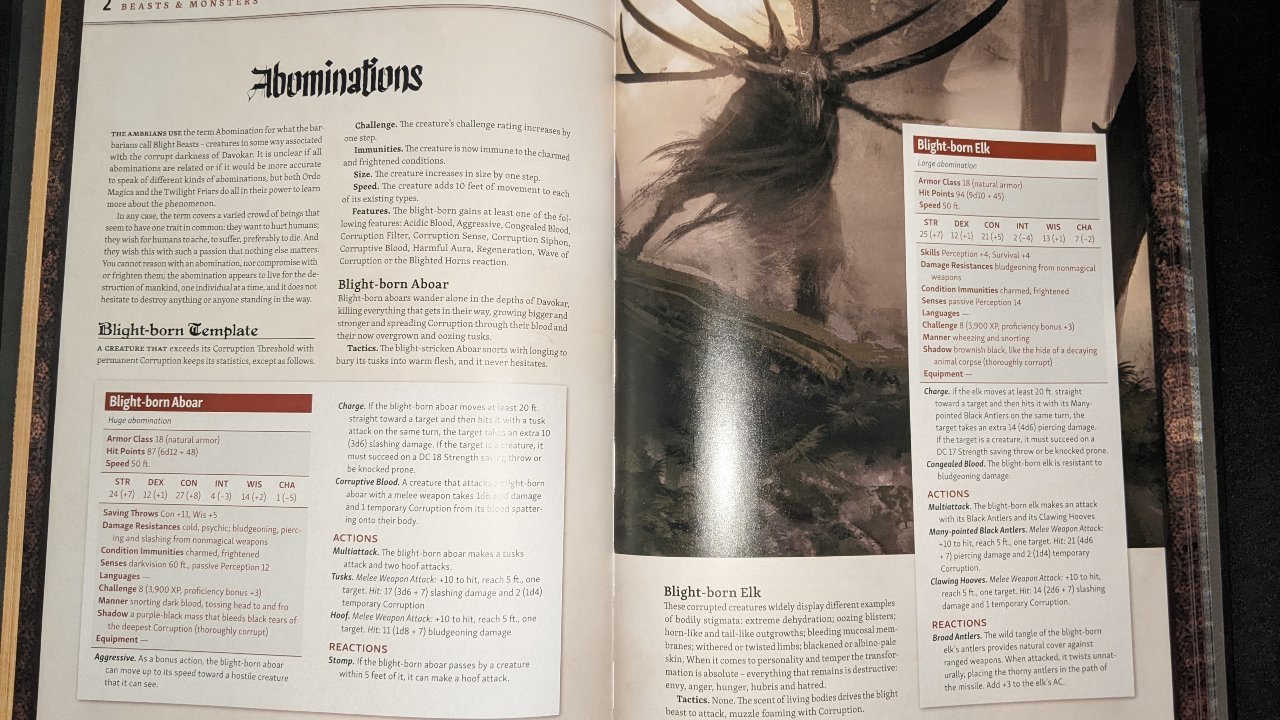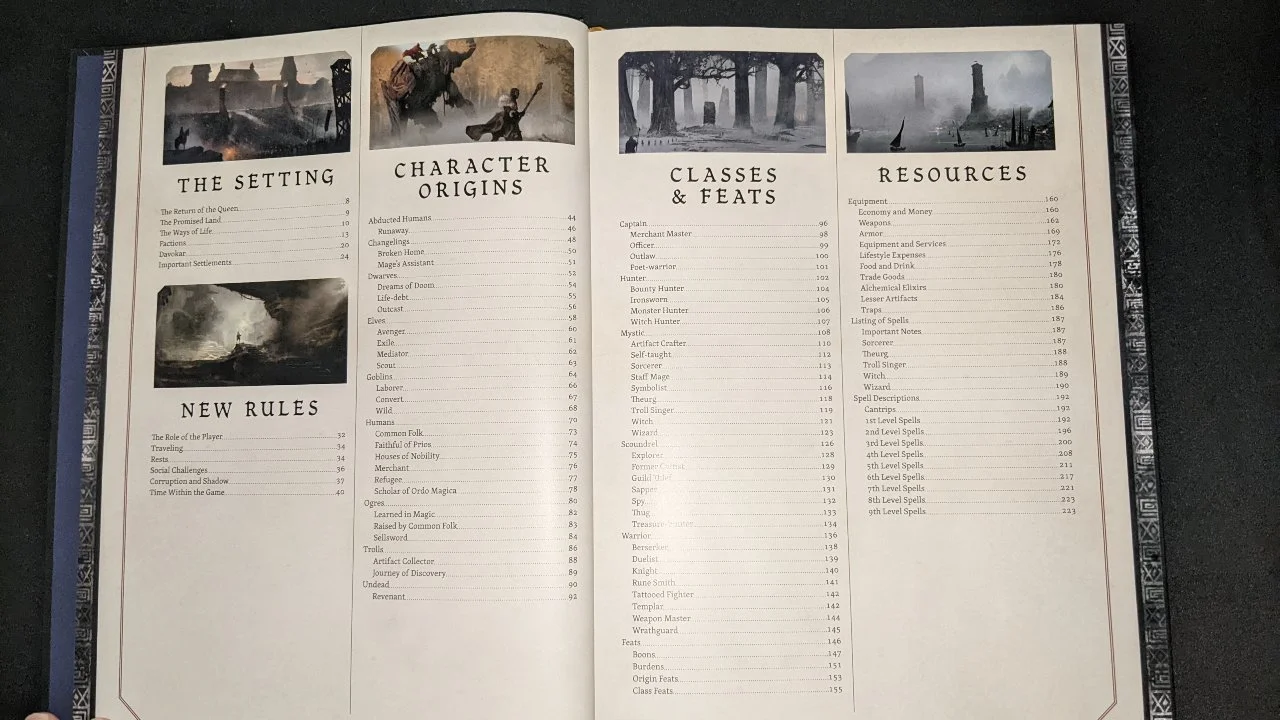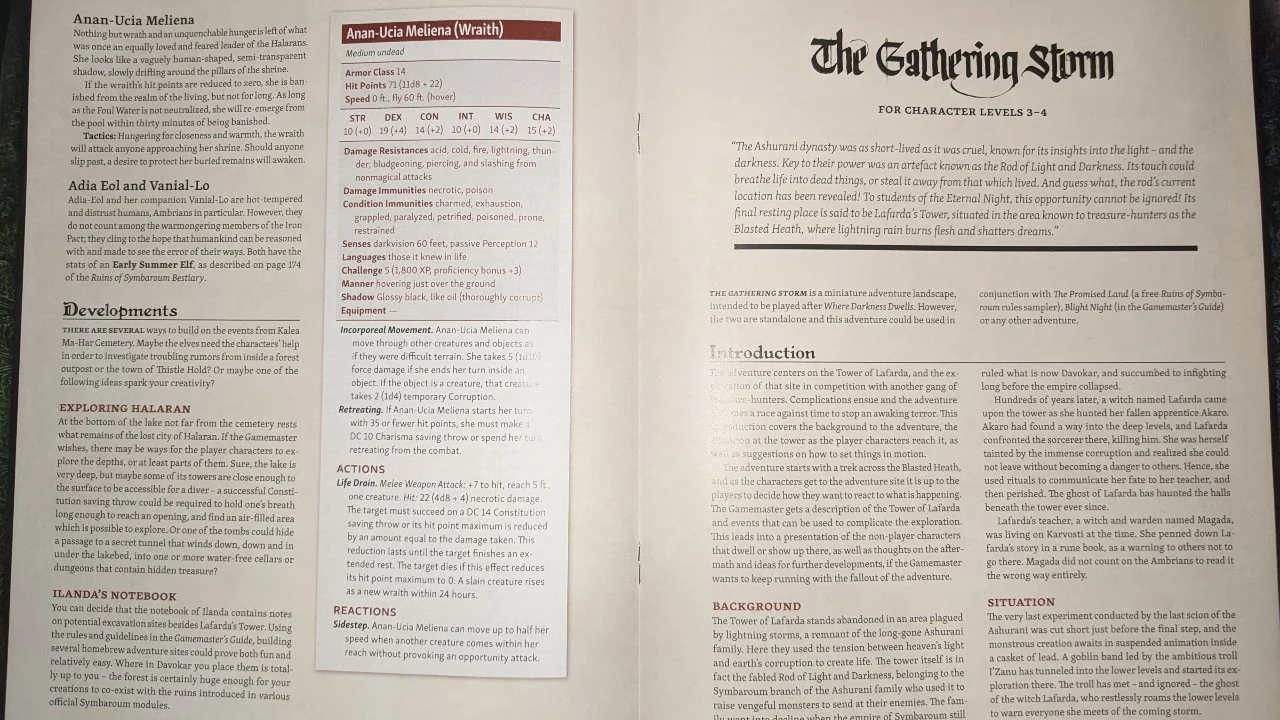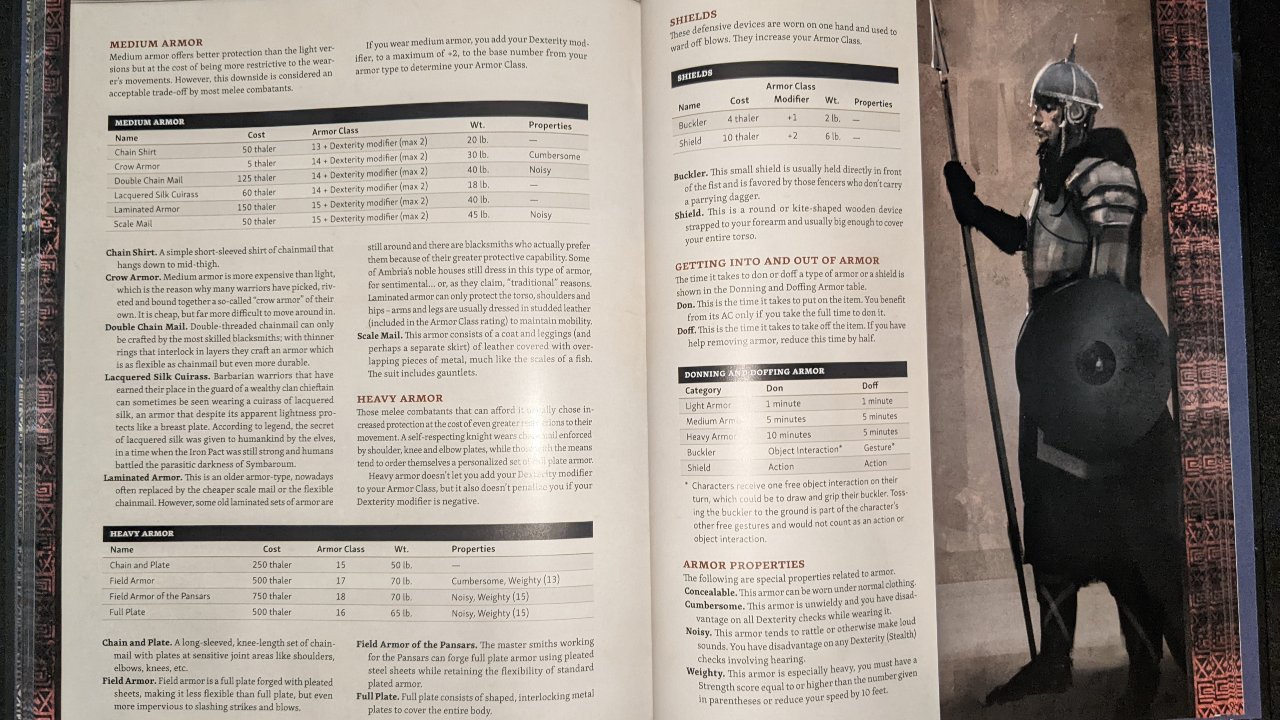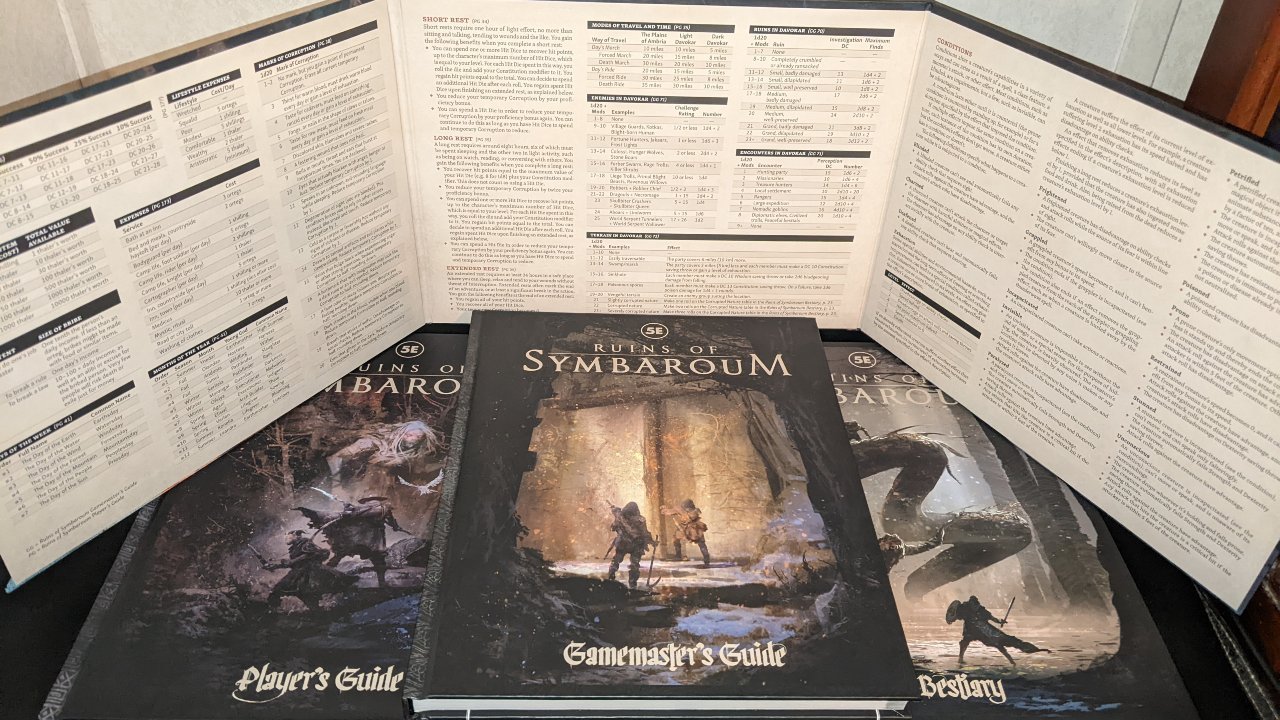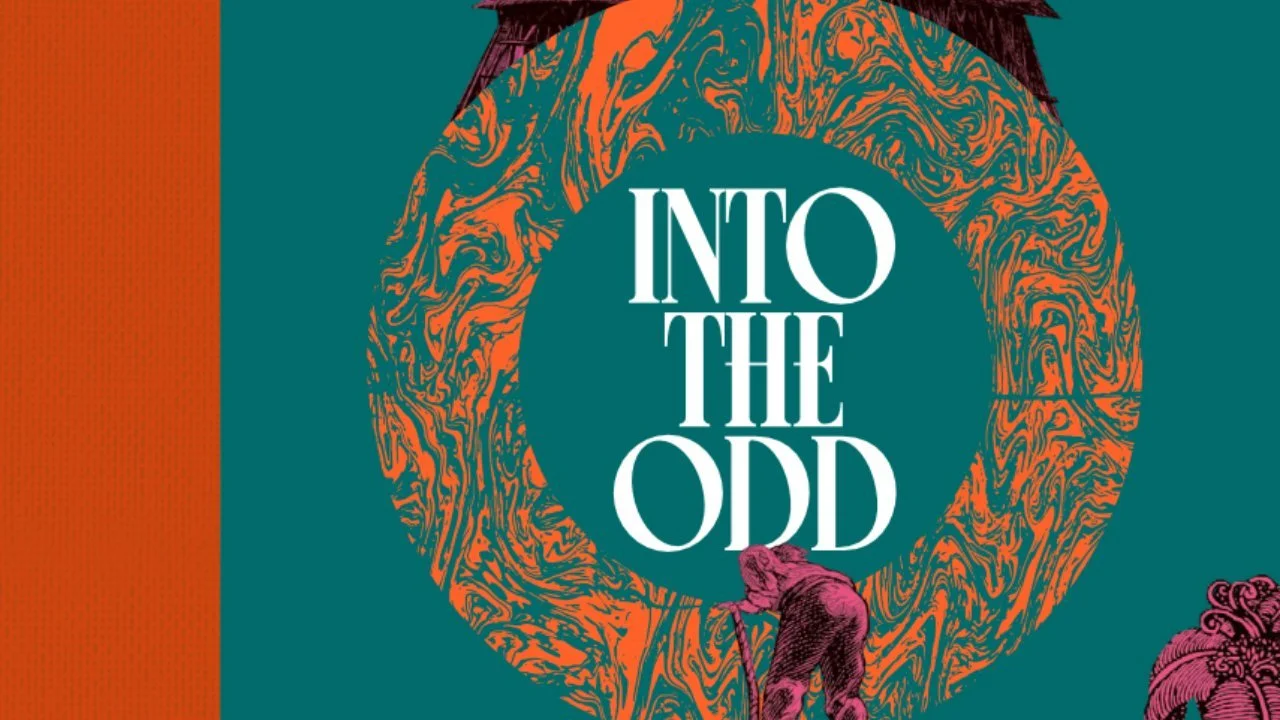Book and PDF Provided by Free League Publishing
When people think of role-playing games, they often lean toward the more popular titles. However, if there is a reason you want to branch away from the popular brands but still want an experience that is similar in rules and style, then Ruins of Symbaroum is the right game for you. This tabletop role-playing game (TTRPG) is one of the latest from Free League Publishing and it was designed under very similar rules and structure as the ever-popular 5E, or 5th Edition, D20 rulebook. However, they do have a few changes that make the game unique.
Gameplay
To get started, you have to make your characters and so we need to look in the Player’s Guide to get that started. In the glossary section (image above), you will see where to find exactly what you are looking for. So, for this version of the game, your character will need a class and origin. You’ll note that the class isn’t the standard setup, but a bit different. In fact, you will pick the overarching class you want and then the subclass detail of exactly who they are.
For instance, if you want to go with a barbarian-style build, you would go with the Warrior-Beserker class. When it comes to building the character you want, they have pretty much everything the popular brands do, except they have their own name and specialties to them. The Origin selection is similar to picking a character’s Background. Picking these two options will ultimately fill out the bulk of your character sheet. Remember to start with your ability scores though, as those numbers are needed. For this, there are a number of styles to go with, but I’m preferred to the classic 4d6 and drop the lowest.
Before you go plugging away your ability scores, I urge you to put some focus on your Charisma regardless of your class. I do this because of this game’s Corruption system. In Symbaroum, the world is overcast by a shadow and there is a balanced struggle between nature and civilization. This has led to people being affected by Corruption. Now, this isn’t an “I feel the power of evil” type, but rather a form of physical alteration. Each character will have a Corruption threshold and certain items, spells, and actions can give them either Temporary Corruption (TC) or Permanent Corruption (PC). Once they get enough Corruption to cross their threshold, the Gamemaster (GM) is to work with the player to roll on the Corruption chart to see what happens to the player. Temporary Corruption can be reduced in a number of ways, but the most usual is through rests. Permanent Corruption never goes away unless they stop using an item giving it to them or another similar situation. You will find that your Charisma plays a role in how harshly you are affected by Corruption, be it your threshold or otherwise.
Focusing back on the player setup side of the game, spellcasters have a lot going on for them. Using spells is part of what causes Corruption for them and so they tend to have a naturally higher threshold for the Shadow. So when it comes to picking out your spells, this should still be taken into account. The back of the Player’s Guide has a full list of spells and then behind that is a full description section for each and every spell in the game. If anything in the handbooks showed that they are making their game out to be its own experience and style, it is the fact that they have their own Spell list.
As for the rest of the details, it is all pretty standard for a TTRPG. Melee, Ranged, and Magic combat have their details fleshed out so you know how much damage and range each weapon and attack has. The armor is all laid out so you can find their Armor Class (AC), down to the point of noting a difference between a Buckler and a Shield. No matter what question I had while trying to set up my game for my players, I was able to find it somewhere in the three main books.
Modules and Enemies
This game provides a long list of details for everything you can ask for. They have their own name for the currency, but it equates to the same styles as Copper, Silver, and Gold. In the Gamemaster’s Guide book, you will find details for services, shops, items, and so much more. You can also find various locations within the world, some main characters in cities, the basis for modules and what they have, and everything else you need to set up your own game. With the combination of the Gamemaster’s Guide, Player’s Guide, and the Beastiary, you will be able to homebrew a campaign all your own with towns, locations, various details, and unique names fleshed out for you.
Also, a cool thing for GMs specifically, the collection comes with a game screen to hide your rules behind and on it, you will find all the important notes you need on hand. How much did a beer cost? What do the players get for a short rest? Many of the typical questions you will have just running a standard game are all detailed right there for your ease of game flow.
Of course, if you’d like to get started with a pre-designed game, then perhaps consider the combination tales “Where Darkness Dwells” and “The Gathering Storm.” These two together make a short campaign for players levels 2-4. Of course, this means you will want to have a makeshift homebrew introduction battle or two so players can get used to their characters before getting started. For this, I like to go with the “met on the road to town” trope as you can have an ambush or encounter happen naturally where they have to work together to get out of the mess giving an initial bond before the campaign.
Looking through the Beastiary, I did notice that this game has a bit higher of a threshold for what they consider their Challenge Rating (CR) compared to what some GMs might be used to. I would suggest considering that Symbaroum’s CR scale is for a party of 5 rather than the usual presumption that the CR scale is for a party of 4. This may seem minute, but if you have GM’ed for a party of 4 and a party of 6, then you know how drastically different the two teams can be.
What It Could Have Done Better
There is only one thing I want to see added to this game - more modules that both start at level one and start at level ten. Campaign modules are the heart of TTRPG’s and while many GMs can homebrew stuff, some people like to get started with a pre-made campaign that can get their players from level one to five or even up to ten. Pre-made campaigns are expected to include all the niche details the game offers, such as Corruption and Magic Items in this case, and it is a good way for both players and GMs to get used to the systems in place, utilizing and applying them properly.
Verdict
Ruins of Symbaroum is the perfect off-brand TTRPG out there that lets users dive into the familiar structure of D20 5E! As updates and news unfold, some users are beginning to stray away from the more popular brands and this game is definitely a great solace for them to turn to. It has its own lore, cities, nature-vs-civilization balance, armor, weapons, creatures, spells, characters, and so much more. They did an amazing job fleshing out this game to be its own experience. An easy top recommendation for anybody who is into tabletop gaming!
Ruins of Symbaroum is available now on the Free League Publishing website and DriveThruRPG.
